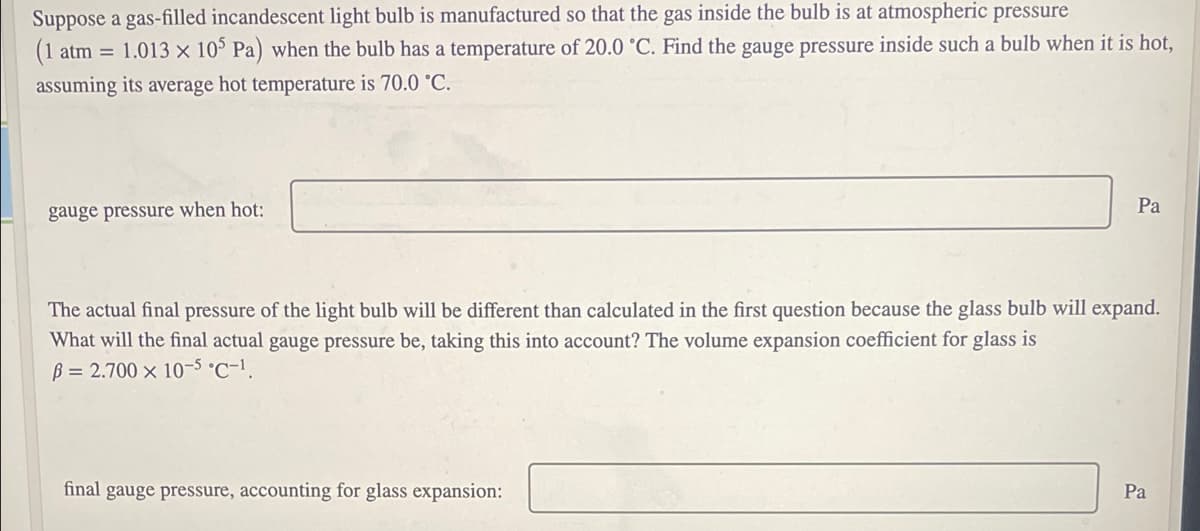Suppose a gas-filled incandescent light bulb is manufactured so that the gas inside the bulb is at atmospheric pressure (1 1.013 x 10 Pa) when the bulb has a temperature of 20.0 °C. Find the gauge pressure inside such a bulb when it is hot, atm = assuming its average hot temperature is 70.0 °C. Pa gauge pressure when hot: The actual final pressure of the light bulb will be different than calculated in the first question because the glass bulb will expand. What will the final actual gauge pressure be, taking this into account? The volume expansion coefficient for glass is B = 2.700 x 10-5 °C-1. final gauge pressure, accounting for glass expansion: Pa
Suppose a gas-filled incandescent light bulb is manufactured so that the gas inside the bulb is at atmospheric pressure (1 1.013 x 10 Pa) when the bulb has a temperature of 20.0 °C. Find the gauge pressure inside such a bulb when it is hot, atm = assuming its average hot temperature is 70.0 °C. Pa gauge pressure when hot: The actual final pressure of the light bulb will be different than calculated in the first question because the glass bulb will expand. What will the final actual gauge pressure be, taking this into account? The volume expansion coefficient for glass is B = 2.700 x 10-5 °C-1. final gauge pressure, accounting for glass expansion: Pa
Chapter2: The Kinetic Theory Of Gases
Section: Chapter Questions
Problem 19P: Suppose a gas-filled incandescent light bulb is manufactured so that the gas inside the bulb is at...
Related questions
Question

Transcribed Image Text:Suppose a gas-filled incandescent light bulb is manufactured so that the gas inside the bulb is at atmospheric pressure
(1
1.013 x 10 Pa) when the bulb has a temperature of 20.0 °C. Find the gauge pressure inside such a bulb when it is hot,
atm =
assuming its average hot temperature is 70.0 °C.
Pa
gauge pressure when hot:
The actual final pressure of the light bulb will be different than calculated in the first question because the glass bulb will expand.
What will the final actual gauge pressure be, taking this into account? The volume expansion coefficient for glass is
B = 2.700 × 10-5 °C-1.
final gauge pressure, accounting for glass expansion:
Pa
Expert Solution
This question has been solved!
Explore an expertly crafted, step-by-step solution for a thorough understanding of key concepts.
This is a popular solution!
Trending now
This is a popular solution!
Step by step
Solved in 3 steps with 3 images

Knowledge Booster
Learn more about
Need a deep-dive on the concept behind this application? Look no further. Learn more about this topic, physics and related others by exploring similar questions and additional content below.Recommended textbooks for you


Principles of Physics: A Calculus-Based Text
Physics
ISBN:
9781133104261
Author:
Raymond A. Serway, John W. Jewett
Publisher:
Cengage Learning

Physics for Scientists and Engineers with Modern …
Physics
ISBN:
9781337553292
Author:
Raymond A. Serway, John W. Jewett
Publisher:
Cengage Learning


Principles of Physics: A Calculus-Based Text
Physics
ISBN:
9781133104261
Author:
Raymond A. Serway, John W. Jewett
Publisher:
Cengage Learning

Physics for Scientists and Engineers with Modern …
Physics
ISBN:
9781337553292
Author:
Raymond A. Serway, John W. Jewett
Publisher:
Cengage Learning

Physics for Scientists and Engineers
Physics
ISBN:
9781337553278
Author:
Raymond A. Serway, John W. Jewett
Publisher:
Cengage Learning

College Physics
Physics
ISBN:
9781285737027
Author:
Raymond A. Serway, Chris Vuille
Publisher:
Cengage Learning

Physics for Scientists and Engineers: Foundations…
Physics
ISBN:
9781133939146
Author:
Katz, Debora M.
Publisher:
Cengage Learning